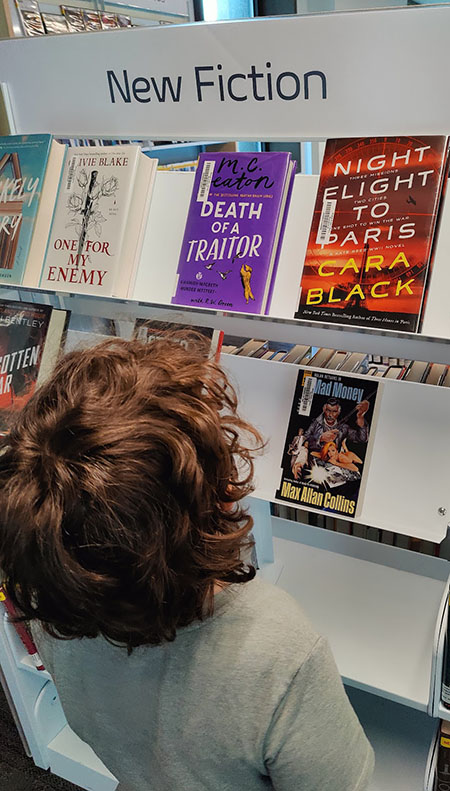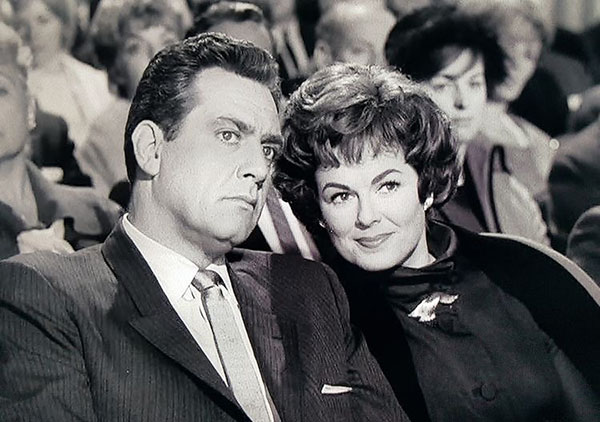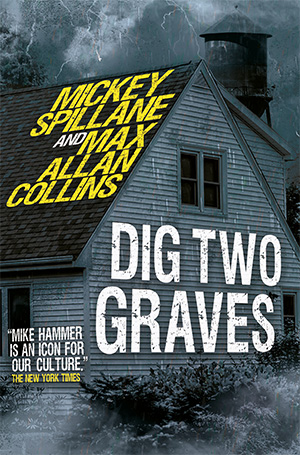Over the years, I’ve had many a bad review from the notoriously tough Kirkus book reviewing service. Lately they have liked me more – perhaps it’s my age. I keep remembering John Huston as Noah Cross in Chinatown observing, “Politicians, ugly buildings and whores all get respectable if they last long enough.”
Here’s how Dig Two Graves is described at the Amazon site:
Mike Hammer, the iconic PI created by the master of noir Mickey Spillane, takes on the mob in the first of two gripping final novels for the deadly private eye.
Winter 1964. After a hit-and-run accident nearly kills her mother, Mike Hammer’s partner (both in life and the PI business), Velda Sterling, learns her father is not who she thought he is. Seeking to uncover her true, troubling heritage, Velda and Mike travel to Phoenix, Arizona – and sunny Dreamland Park, where retired law enforcement officers protect and corral notorious criminals held under Witness Protection.
Mike and Velda find themselves swept up in escalating violence, fueled by the missing millions from an armored-car robbery, which leads them to a deadly midnight confrontation in a cemetery – where secrets are buried and open graves await.
Speaking of Mike Hammer, a Facebook scribe in the midst of a bunch of nice praise by others for the Spillane/Collins novels tried to dissuade Spillane fans from reading these novels, thusly: “The parts by Mickey are great, (but) when it shifts, it stops reading like Mickey and I’ve studied Mike hammer novels for my own writing back when and can tell the difference. I like when Collins writes his own characters but not much on the hammer.”
Here’s the thing: this reader makes the assumption that when Mickey’s material runs out, I take over and finish up the book. Some of you may recall, from previous posts and from an essay in the back of Spillane – King of Pulp Fiction – that this assertion is as inaccurate as it is confident. With the longer Spillane manuscripts – the 70-page to 100-page ones – I expand the material to fill to double that length. So my work is interspersed with his from the start. That’s partly to create a consistently shared voice that I can continue when the Spillane material runs out.
But that’s an over-simplification, because I have used the material in Mickey’s extensive files in a bunch of ways. For example, I sometimes combine manuscripts – Lady Go, Die! is mostly from the late ‘40s, but I weave in a similar serial killer chapter from the ‘60s to provide more genuine Spillane material. In Complex 90, the books begins with Spillane (expanded by Collins), then flashes back to a Hammer in Russia sequence I wrote, then when we come forward and Mike is back in New York, I’m working from Mickey’s material again.
Also, I have scraps of Spillane, paragraphs that he jotted down – descriptions of Manhattan, action scenes – that I weave in when I can. Sometimes he has provided plot and character notes that I use; other times he has written a rough draft of the ending. I worked from the more extensive manuscripts at the beginning, because I wanted to get that stuff out there – The Goliath Bone; The Big Bang; Kiss Her Goodbye; Lady, Go Die!; Complex 90; King of the Weeds; Kill Me, Darling; Killing Town. Murder Never Knocks had several chapters and a last chapter from Mickey; The Will to Kill had a few opening chapters but the mystery was wholly set up as if a blueprint had been given me; Murder, My Love and Masquerade for Murder came from Spillane synopses with scraps of description and action by him from the files woven in.
Both Goliath Bone and Kiss Her Goodbye had two versions of their partial manuscripts, which in both cases I combined. The former also had half a dozen versions of the first chapter. The latter shared the same basic premise but went off into two entirely different mysteries, which I combined. Kill Me If You Can utilized an unproduced TV pilot Mickey wrote. The upcoming Dig Two Graves combines two unfinished manuscripts, including a first pass at Dead Street, and this – Dreamland Park – was the major building block of Graves. But the other unfinished manuscript suggested an evocative back story involving a gangster who had fathered Velda.
A lot of work and, frankly, ingenuity goes into this process, and I frankly resent it when supposed hardcore Spillane fans turn their noses up because I’m involved and not every word choice sounds to them like Mickey would have made it.
I don’t try to write like Mickey – I don’t have to. I took in his words like vitamins starting when I was 12. I concentrate on getting Hammer himself right – Mickey considered character all important. Now and then I have a spooky burst like he is taking over. I was watching TV one Sunday morning (during the writing of Goliath Bone) and I suddenly reached for a scrap of paper and in a blistering array of words recorded the last few paragraphs of the novel. To me, they read like the Mick. It felt like automatic writing.
Here’s the thing: when Mickey, not long before his passing, asked me to complete the unfinished material in his files – in part to keep his name out there, but primarily to provide some income for his wife, Jane – he made it clear that these would be collaborations. When Jane reminded Mickey that I was not a Jehovah’s Witness and would likely indulge in more sex and violence than had been in his more recent work, he was fine with it.
Listen, these books are not pure Spillane. They are Spillane/Collins collaborations. I am not writing them by working with a Ouija board. I bring my own sensibilities in, but do not let them swamp Mickey’s. There are differences between Spillane and Spillane/Collins, just as in any good collaboration the end result is two plus two equals five. My Hammer novels reflect my wise-guy sense of humor more than Mickey’s Howard Hawksian male kidding. I do some of the latter, but I am not about to leave my wit behind when I work on Hammer.
I also tend to give Velda more to do. Mickey created a great character in her that I like to utilize, particularly in the post-Girl Hunters material. I also pay more attention to continuity than Mickey did. Like Rex Stout, Mickey paid scant attention to the details of continuity, though time-passage shifts in character (echoing his own over the years) are a huge part of his work.
I have tried to make sense of some things, to make them hang together. The origin for Velda (in the LP Mickey Spillane’s Mike Hammer Story) I re-reworked giving her a vice cop background that made it possible for Velda to get a PI license in New York state, and for her to have a reason to abruptly abandon Mike (in Kill Me, Darling) to pursue her vice cop boss’s murderer in Florida. (That novel, by the way, combined two Spillane manuscripts.)
So, yes, to some degree this is my take on Hammer, not Mickey’s. But, as I say, my mandate is to be consistent with the character as Mickey conceived him. And, further, to keep each Spillane/Collins novel in the context of when Mickey wrote the material I am working from. This means when I write King of the Weeds, I’m doing the older, Killing Man/Black Alley Mike Hammer; and when I’m putting together Kill Me, Darling and Killing Town, it’s the young Hammer of I, the Jury and My Gun Is Quick. Many of the books – The Big Bang, Kiss Her Goodbye, Complex 90 – were begun by Mickey in his “comeback” period, after The Girl Hunters (1962).
Some Hammer fans only like those first wonderful six ‘40s/’50s novels, from I, the Jury to Kiss Me, Deadly. Understandable, as those are masterpieces of the genre. I most enjoy writing about early, psychotic Hammer – from the very first novel about him (Killing Town) to exploring his descent into the bottle (Kill Me If You Can). But my job was to complete the books Mickey began – so if it was a ‘60s manuscript, the ‘60s Hammer was who I wrote about; if it was an early 21st Century manuscript, I wrote about that older Hammer. It was Mickey, not me, who put a cell phone in his hero’s hands.
I don’t mean to suggest that I’ve had a lot of criticism from Hammer fans – quite the opposite. And the reviewers have largely come around to the once reviled Mickey and Mike, through my efforts. It’s gratifying.
Still, it’s disappointing that a few hardcore Spillane/Hammer fans are denying themselves these novels, particularly ones like The Big Bang and Complex 90, which were announced during Mickey’s lifetime. When I remember how frustrating it was to be waiting for those books to come out – waiting and waiting and waiting – and now to glance across my office to the bookcase where the shelf of the Spillane/Collins hardcovers reside, and see those very titles looking back at me…wow. The long wait is over.
Elsewhere – and here, a little – I’ve discussed the HBO reboot of Perry Mason. And I’m going to do that again – right now.
First, an interesting take on reboots from my eight year-old grandson, Sam. His father, Nathan, was telling him about the upcoming Teenage Mutant Turtles movie. Both Nate and Sam are Turtles fans, you see. Sam has a remarkable sense of what he’s ready for, in terms of pop culture that may not be appropriate for a boy his age.

Sam Collins is astonished to see his grandfather’s name on a book at the local library.
When Nate told Sam about the upcoming Turtles movie, Sam thought it might not be right for him. Nate asked him why.
“It’s a reboot.”
Nate said it was a reboot, yes.
“Well,” Sam observed, “reboots are dark.”
And isn’t that the truth. The Michael Keaton Batman, decades ago, started the trend – reboots had to be dark and serious and grown-up, even when the subject matter was inherently juvenile.
The HBO Perry Mason, which has considerable merits, is a case in point, sort of. Erle Stanley Gardner was one of the best mystery writers of his day, and remains eminently readable. His Mason novels are like James M. Cain stories combined with a mystery – the same Cain-like subject matter, sex and money, and (again, like Cain) display a genuine interest in how businesses work. Perry and his secretary Della Street had a warm relationship that one assumed was sexual, away from work…but we rarely saw them away from work. Mason and his detective, Paul Drake, reflected the way criminal lawyers work, i.e., with an investigator or investigative staff.
Mason, well into the 1950s, was something of a sleaze. Remember the line in Better Call Saul? “You don’t need a criminal lawyer…you need a criminal…lawyer.” Perry hid clients, messed with evidence, switched guns, broke and entered, and it was just delightful.
A lot of that went into the first few seasons of the original Raymond Burr series. Some of that gets into the good but not great HBO reboot. The second season of the new Mason was a big improvement, but it still suffers from anachronisms (it’s set in the early ‘30s) and with a subservience to current sensibilities. Some of that doesn’t hurt, even helps. Paul Drake, for example, is Black here, and lives in a Black part of town; this puts flesh on the Gardner Drake’s bare bones and is an enhancement. But do both Della and Hamilton Burger have to be gay? Isn’t one of them enough? Must Della be Perry’s pal and not sly lover? Must she really be a superior lawyer to Perry, even though she isn’t one? Did I really see him (and an unsympathetic judge!) allow her to handle a key courtroom cross-examination in a murder trial? In 1934?
Yikes.
But if you’re young enough, you won’t care; and if you’re old enough, and haven’t thrown anything through the screen yet, you’re in for some good acting, crafty plot twists and great production values.
My advice to the producers of this series (which will not be heeded) is to at least make Della bisexual so she and Perry can be more than good buddies. And stop using phrases like “throwing shade” and “gaslighting,” and instead make use of actual colorful ‘30s argot.
Also, read some Gardner and watch some Raymond Burr Perry Mason episodes. (I did a project with Burr and he was a wonderful, smart man with a great sense of humor. He was planning to have Perry marry Della in the final of the later TV movies.) Right now Paramount Plus is running the first eight (of nine) Perry Mason seasons. The series is also available on DVD.

Raymond Burr and Barbara Hale as Perry Mason and Della Street
To you mystery fans out there, I would recommend the many episodes based directly on Gardner’s novels. The non-Gardner-derived episodes are entertaining but cookie-cutter, where Gardner is a wild, unpredictable ride, rarely telegraphing which character will be the murder victim. The first season of the series consists almost entirely of adaptations of Gardner Perry Mason novels (or short stories) – something unique in the history of American broadcasting. The second season is about half Gardner adaptations, and then after that it’s more sporadic. As it progressed, the show was actually adapting Gardner novels within a year or so of publication! Toward the end of the long run of the series, remakes of adaptations were also made, under new titles.
I tried hard to find a list of the Gardner adaptations on the Internet, to no avail. I decided to put just such a list together, for myself and Barb and, dear reader, you. You are very welcome.
Perry Mason Episodes
Based on Erle Stanley Gardner’s Novels and Short Stories
Season 1 (1957 – 1958)
1. The Case of the Restless Redhead
2. The Case of the Sleepwalker’s Niece
3. The Case of the Nervous Accomplice
4. The Case of the Drowning Duck
5. The Case of the Sulky Girl
6. The Case of the Silent Partner
7. The Case of the Angry Mourner
8. The Case of the Crimson Kiss
9. The Case of the Vagabond Vixen
10. The Case of the Runaway Corpse
11. The Case of the Crooked Candle
12. The Case of the Negligent Nymph
13. The Case of the Moth-Eaten Mink (pilot)
14. The Case of the Baited Hook
15. The Case of the Fan-Dancer’s Horse
16. The Case of the Demure Defendant
17. The Case of the Sun Bather’s Diary
18. The Case of the Cautious Coquette
19. The Case of the Haunted Husband
20. The Case of the Lonely Heiress
21. The Case of the Green-Eyed Sister
22. The Case of the Fugitive Nurse
23. The Case of the One-Eyed Witness
25. The Case of the Empty Tin
26. The Case of the Half-Wakened Wife
28. The Case of the Daring Decoy
29. The Case of the Hesitant Hostess
30. The Case of the Screaming Woman
31. The Case of the Fiery Fingers
32. The Case of the Substitute Face
33. The Case of the Long-Legged Models
34. The Case of the Gilded Lily
35. The Case of the Lazy Lover
37. The Case of the Black-Eyed Blonde
38. The Case of the Terrified Typist
39. The Case of the Rolling Bones
Season 2 (1958 – 1959)
41. The Case of the Lucky Loser
44. The Case of the Curious Bride
45. The Case of the Buried Clock
50. The Case of the Perjured Parrot
52. The Case of the Borrowed Brunette
53. The Case of the Glittering Goldfish
54. The Case of the Foot-Loose Doll
58. The Case of the Caretaker’s Cat
59. The Case of the Stuttering Bishop
62. The Case of the Howling Dog
63. The Case of the Calendar Girl
65. The Case of the Dangerous Dowager
66. The Case of the Deadly Toy
68. The Case of the Dubious Bridegroom
69. The Case of the Lame Canary
Season 3 (1959 – 1960)
72. The Case of the Garrulous Gambler
79. The Case of the Lucky Legs
86. The Case of the Mythical Monkeys
87. The Case of the Singing Skirt
Season 4 (1960 – 1961)
111. The Case of the Waylaid Wolf
121. The Case of the Duplicate Daughter
Season 5 (1961 -1962)
139. The Case of the Shapely Shadow
144. The Case of the Mystified Miner
Season 6 (1962 – 1963)
166. The Case of the Shoplifter’s Shoe
175. The Case of the Velvet Claws
Season 7 (1963 – 1964)
184. The Case of the Drowsy Mosquito
187. The Case of the Reluctant Model
188. The Case of the Bigamous Spouse
197. The Case of the Ice-cold Hands
204. Case of the Woeful Widower (Fiery Fingers)
Season 8 (1964 – 1965)
224. The Case of the Blonde Bonanza
235. The Case of the Careless Kitten
239. The Case of the Grinning Gorilla
241. The Case of the Mischievous Doll
Season 9 (1965 – 1966)
244. The Case of the Candy Queen (Silent Partner)
246. The Case of the Impetuous Imp (Negligent Nymph)
255. The Case of the Golden Girls (Vagabond Virgin)
258. Case of the Vanishing Victim (Fugitive Nurse)
260. Case of the Sausalito Sunrise (Moth-eaten Mink)
265. Case of the Fanciful Frail (Footloose Doll)
M.A.C.










